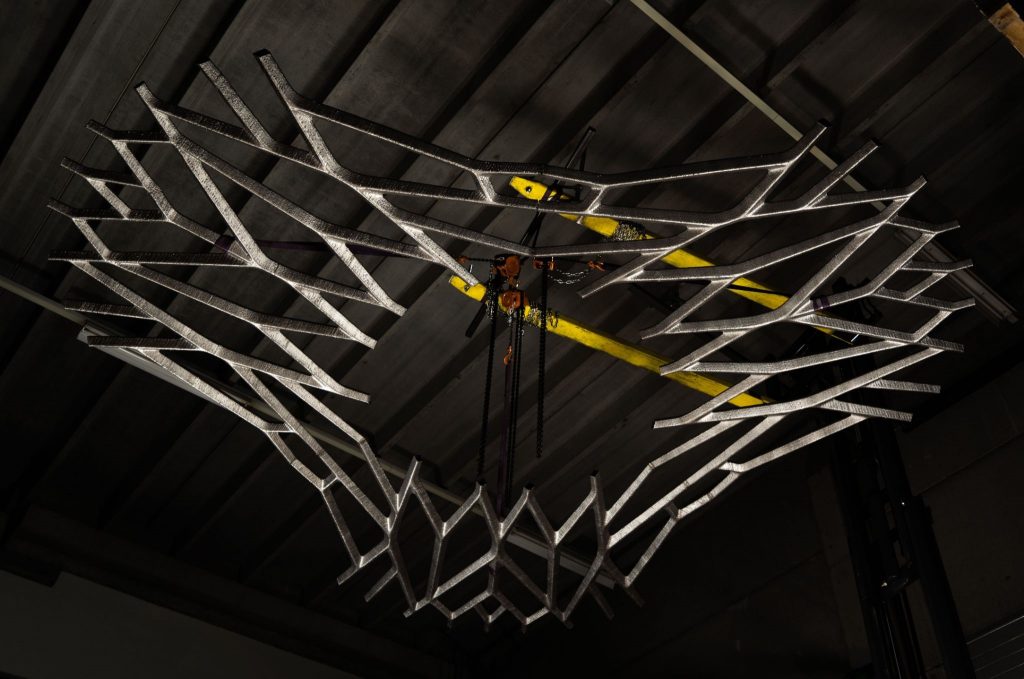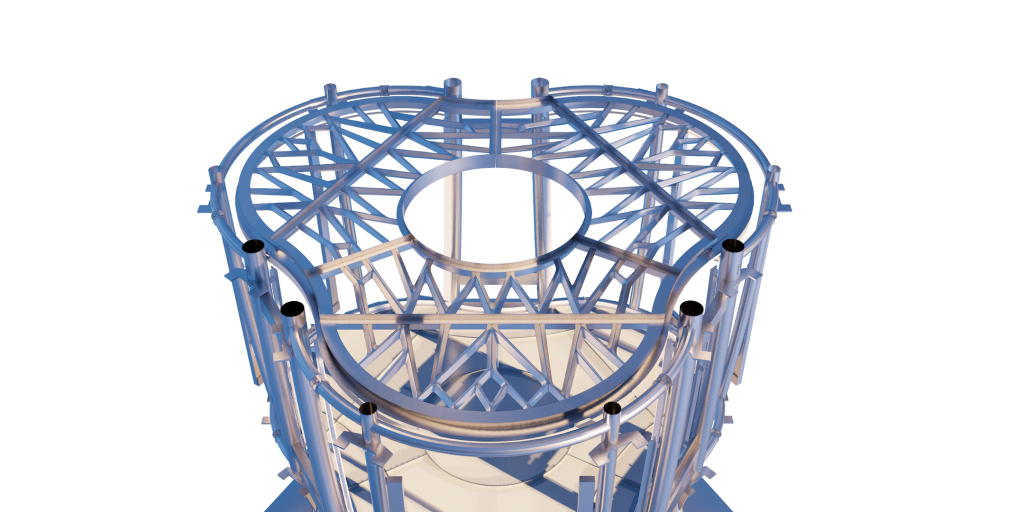Dutch robotic metal 3D printing firm MX3D has constructed a novel material-efficient ‘skeletal floor’ for a prototype European Space Agency (ESA) lunar settlement.
By combining delineating stress map analysis with 3D printing, the company has been able to construct an ultra-lightweight steel structure with a smooth web-like design, at a reduced mass of 395 kilograms. According to ESA engineer Advenit Makaya, the project has shown the efficiency and lunar manufacturing potential of MX3D’s technology, which could be used to build regolith-based structures in future.
“This is a remarkable achievement from MX3D, which further highlights the potential of this additive manufacturing technique for an increasing range of space applications,” said Makaya. “The design flexibility, and the possibility to combine the printed structure with embedded monitoring systems, are worth investigating for applications in space structures.”
“This technique could also be considered for the in-situ construction of infrastructure during sustainable exploration missions, by using metallic feedstock derived from the locally-available regolith.”

A stellar ‘skeletal’ design
Built for a four-storey prototype ESA Moon habitat being developed by architecture firm Skidmore, Owings and Merrill (SOM), MX3D’s floor has been topologically-optimized to be as material-efficient as possible. In practise, this means that the structure was 3D printed using the firm’s proprietary WAAM technology into six vertical segments, before being welded into a cohesive substructure.
Upheld by three columns, the floor features a series of panels that form a ‘mesh’ capable of acting as a supporting structure without needing to be ‘filled-in,’ while its overall design cantilevers towards its perimeter and center, allowing these areas to be 3D printed at a reduced thickness, but not at the cost of cohesion or integrity.
“We looked at the manufacturing constraints and used our analysis to interpolate a web pattern that followed the angular limits of the 3D printing machines,” explains Daniel Inocente, SOM’s Senior Designer for the project. “The cross-section and thickness was also analyzed and differentiated to reduce the overall mass – with reduced thickness at the exterior/interior boundaries.”
Taking around 246 hours to build, the 308LSi stainless steel floor has now been finished, and once pieced together, it measures some 4.5 meters across. Ultimately, the structure wasn’t able to feature as part of SOM’s ‘Life Beyond Earth’ Venice Biennale exhibit as intended, but according to MX3D CEO Gijs van der Velden, the project has still demonstrated the lightweighting potential of its technologies.
“It was a perfect project for MX3D to leverage its experience in printing topology-optimized metal structures,” concluded van der Velden. “Achieving an optimal use of material is a company goal at MX3D because – just as when designing space applications – every reduced kilo in a MX3D design is a direct win for a project’s feasibility.”

MX3D’s construction expertise
Based around Metal XL, a software MX3D describes as the “first dedicated to robotic WAAM,” and printer-mounted ABB machinery, the firm’s approach enables the construction of custom large-scale architecture. In recent times, the company has also begun manufacturing its own systems with the M1 3D printer, which recently gained a cash injection of €2.25 million to fund its further R&D and release.
Since launching in 2015, the company has steadily scaled the application of its technologies, from its first 3D printed ‘Arc’ bike in 2016, up to a steel bridge connector that was said to generate significant “interest from construction companies” back in 2019.
Using its unique WAAM approach, the company has also taken to building bridges, and it unveiled its first such 12 meter-long structure at Amsterdam’s Oudezijds Achterburgwal canal in June 2021. Working with the CSIC, Imperial College London and Alan Turing Institute, MX3D has been able to incorporate sensors into the build, enabling the gathering of data for the creation of a digital twin of the structure.
At the time, van der Velden claimed that the bridge was “only the beginning” for the firm’s technologies, and following the success of its recent aerospace project, the ESA’s Head of the Materials and Processes Thomas Rohr, has now spoken out about the space-faring potential of MX3D’s robotic-led technologies moving forwards.
“The capabilities of MX3D demonstrate inspiring concurrence of engineering and art, and are another great example to what extent AM has already entered our society,” concluded Rohr. “For space applications, such technologies not only provide improvements in performance, but can lead to unprecedented and enabling design solutions.”
3D printing in outer space
While no doubt demonstrating increasing scalability, MX3D’s 3D printing technologies aren’t the first to have been enlisted for constructing homes on other worlds. Texas-based ICON, for instance, has been tasked by NASA with developing an off-world construction system that’s capable of building a permanent Moon base using only lunar regolith.
More recently, ICON has also been contracted to 3D print a martian habit that accurately recreates the conditions astronauts will experience when they visit the surface of Mars. Starting next year, the structure is set to house a three-year NASA field test, trialling the efficacy of its nutrition system, as well as the physical and behavioral impact of prolonged exposure to life on the red planet.
Meanwhile, outside the U.S, scientists at the Technical University of Braunschweig and Laser Zentrum Hannover (LZH) have managed to 3D print lunar regolith in zero gravity for the first time. The team’s rover-mounted laser melts moondust into lunar structures, saving flight operators from having to ship heavy cargo from Earth to the Moon’s surface.
To stay up to date with the latest 3D printing news, don’t forget to subscribe to the 3D Printing Industry newsletter or follow us on Twitter or liking our page on Facebook.
For a deeper dive into additive manufacturing, you can now subscribe to our Youtube channel, featuring discussion, debriefs, and shots of 3D printing in-action.
Are you looking for a job in the additive manufacturing industry? Visit 3D Printing Jobs for a selection of roles in the industry.
Featured image shows MX3D’s stainless steel 3D printed lunar floor. Photo via the ESA.



